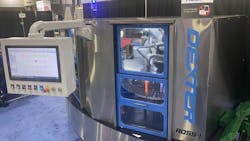For companies in the beef, pork or poultry industries, a ready supply of sharp knives is critical for employees involved in the processing of animal carcasses. When knives begin to blunt with use, it is readily apparent, and blunt knives are quickly set aside for resharpening. Manual knife resharpening can be performed by knife manufacturers or specialty services who employ teams of well-trained, skilled personnel to provide quick turnaround and deliver sharp and consistent edges back to the customer. One major knife manufacturer was experiencing inconsistencies in edge quality, escalating labor costs, and high employee turnover, which was, in turn, leading to variation in the knives delivered to customers as newer employees struggled to ramp to higher levels of proficiency. That company turned to a machine vision and automation solutions provider to design and build an automated knife-sharpening system to save cost as well as address the risks and inconsistencies associated with manual knife-sharpening.
The Design Challenge
For an automated sharpening system to meet the customer’s minimum return on investment criteria, it needed to have a fast cycle time, to randomly and instantly recognize a wide range of different knife attributes, to sharpen at a range of different edge angles, and deliver a very sharp and consistent edge along the length of each blade, according to Scott Crawley, President of VAIA Technologies (Westborough MA, USA, www.vaia-tech.com), a machine vision integrator and automation company founded in 2002.
According to Crawley, the amount of material removed during a sharpen is also very important. “A typical knife might undergo 20 to 25 manual resharpens during its useful lifecycle,” he says. “Other automated systems apply downward pressure to push a knife between two opposing grinding wheels. While these processes can certainly produce good edges, you don't really have full control over how much material you're taking off. Our research had shown that if we could find a way to take off only the minimum amount of material required to achieve an Anago (sharpness) score of 8.5 or higher, we would potentially increase the lifecycle of an individual knife to 35 to 40 sharpens.”
VAIA collaborated with its customer, Dexter Russell, and SMS, one of Dexter’s resharpening service partners, on many other system design requirements as well. For example, the system needed to be operated and reloaded concurrently; the user interface needed to be simple enough that lesser-skilled employees could operate it with ease; and consumables, such as grinding belts, polish compound, and robot gripper inserts, needed to be easily replenished or replaced with minimal system downtime. The system also needed to be safe. The end result of the design process was the Ross-1 Automated Knife Sharpening System.
The New Process
VAIA’s approach to designing the Ross-1 System centered around using 3D vision scanning, a six-axis robot, an innovative mechanical design, and a custom software interface. Unlike other systems, the Ross-1 robot picks knives up by the blade rather than the handle, which provides for increased stability and precision during the sharpening process. The knife is then passed between two parallel Teledyne DALSA (Waterloo, ON, Canada; www.teledynedalsa.com) Z-Trak2 3D laser profilers that use 405-nm blue lasers, offer 100-mm ranges, and communicate via GigE interfaces. These units capture precise 3D images of both sides of the blade at the same time. Earlier prototypes for the system used one scanner, so the robot had to flip the knife in order to do the second side. Using two scanners concurrently improved system cycle time significantly.
After the Z-Trak2 scanners take the 3D scan, the robot has an exact profile of the knife—the width, length, and curvature. Based on this information, the robot can precisely sharpen the knife as it maneuvers the knife to exactly match the scan’s profile as it sharpens through to the tip, with the grind process removing only the amount of material required to achieve a sharp edge. Crawley says, “This methodology allowed knife SKUs to be loaded at random into the carousels, with the scan of the actual knife providing the information to the robot on what it was holding and what it needed to do next. Implementing a continuous vison calibration feedback loop meant that our level of precision went beyond the precision of the robot itself.”
To use the system, an operator loads one of two carousels, each having a 64-knife capacity. Using dual carousels allows one to be reloaded by an operator without interrupting the robot as it removes and replaces knives from/to the other. The operating carousel indexes so the system’s ABB (Zürich, Switzerland; www.abb.com) IRB1200-7/0.7 robot is aligned perfectly to pick up the next knife to be sharpened. After picking up a knife and passing it through the scanners, the robot makes two passes across a grinding belt to sharpen both sides of the knife, then presents the knife to a final polishing wheel where both sides are honed, before finally replacing the knife back in the carousel. The process is repeated for each subsequent knife. Said Crawley “The entire process for one knife—pick and place, 3D scanning, grinding, and polishing—takes approximately 28 seconds for an average knife, allowing the system to sharpen up to 3,000 knives per day”.
The Ross-1’s custom processing and user interface software was built in SurePro, a proprietary software package developed by VAIA that uses a Cognex (Natick, MA, USA; www.cognex.com) VisionPro 9.2 vision library to process the 3D images and extract dimensional information for creating sharpening/polishing trajectories. “We're sharpening a blade down to a 7- or 8-µ width at the edge and we're doing it consistently along the length of that blade and then doing it blade after blade after blade,” says Crawley. “Obviously our team put a lot of work into developing the vision software, and especially the proprietary calibration algorithms that are critical to achieving this extremely high level of precision with a six-axis robot.”
Processing power for the system comes from a Neousys Technology (Northbrook, IL, USA; www.neousys-tech.com) Nuvo-5000 industrial embedded computer featuring an Intel (Santa Clara, CA, USA; www.intel.com) i7-6700, five GigE ports, and one Ethernet port.
Challenges
As with many machine vision systems, real world conditions are often very different than those in a lab and for this system, it was no different. “Corner cases will always bite you,” says Crawley. “You know, the one knife out of 100 that's really different—maybe a bend, a chip, it wasn’t cleaned properly prior to loading, or it’s unexpectedly shiny. Specular reflection was a big challenge.” Crawley explains that sharpening older knives that had previously been sharpened manually was another challenge. “We've got to be able to sharpen new knives directly from the manufacturer but also sharpen older knives and then keep resharpening them down to end of life where the remaining width for the robot grippers to pick up the knives might be as thin as 5/8 in.,” he says. “The wide mix of blade widths required us to design an innovative, cost-effective, replaceable robot gripper insert assembly to compensate for the inevitable wear on these components but also to ensure we were providing for maximum grip strength no matter how thin the knife.”
Resolving more systemic issues are just as important when trying to deliver a successful system in the field. Crawley says, “We had issues with unexpectedly high amounts of metal dust floating in the air at one of the customer facilities, which wreaked havoc with the robot controller, the fan motor, etc. and required us to rapidly design and deploy incremental field-installable filter assemblies to keep the dust out. Our Roboze (Houston, TX, USA; www.roboze.com) Argo 500 3D printer was a huge asset in enabling rapid turnaround time on rework cycles.”
There are also instances where the employee loading the knives must know when a knife has reached the end of its useful life and not load it into the system. If the blade is less than 5/8 in. wide, it starts to resemble a toothpick, according to Crawley. “As a blade gets thinner from repeated resharpening, there’s a point where we are not going to be able to grip enough of the blade to hold onto it reliably under the pressure of the grinding and polishing processes,” he says. “If we try to sharpen it, it’s going to flip out of the grippers and be thrown.” Crawley explains that there are a couple of ways to address this challenge. One is to provide more training to the employees and give them gauges so they do not place out-of-spec knives into the carousels. “Maybe the more fail-safe way to do it,” he says, “is once you do the scan, if you're not seeing what you need to see, that [knife] goes in the trash, and we tell the customer that that knife was too thin, or too short, or whatever it might have been. The reality is that no matter how well operators are trained, at some point it’s inevitable that an out-of-spec knife will be accidentally loaded into the system.” Manually sharpening a knife beyond end of life has produced rare cases where a thin knife has snapped during the process and a flying section of the blade ended up stabbing an operator. Because VAIA invests significant development effort in the design of safety systems for system enclosures, door mechanisms, and eStops, any issues of this nature will always remain confined to the Ross-1’s secure enclosure and far away from the operator or any other personnel.
Crawley says that feedback from the end customers has been valuable, explaining that once a customer has experienced knife edges coming from the automated Ross-1 System, it then prefers not to revert back to less consistent, manually-sharpened knives. “It’s been a long road working through all of the various issues, so it’s gratifying to get great feedback from the customers on sharpness, edge consistency, and durability as well as their appreciation for the flexibility of the system to sharpen any knife put in front of it. This feedback has been a real validation of our design process which included soliciting as much input we could from our customer at the outset of the process and at every point throughout. We’re off to a great start and we have high expectations that there are significant applications for this outstanding vision technology beyond the meat processing and knife industry.”
About the Author
Chris Mc Loone
Editor in Chief
Former Editor in Chief Chris Mc Loone joined the Vision Systems Design team as editor in chief in 2021. Chris has been in B2B media for over 25 years. During his tenure at VSD, he covered machine vision and imaging from numerous angles, including application stories, technology trends, industry news, market updates, and new products.



